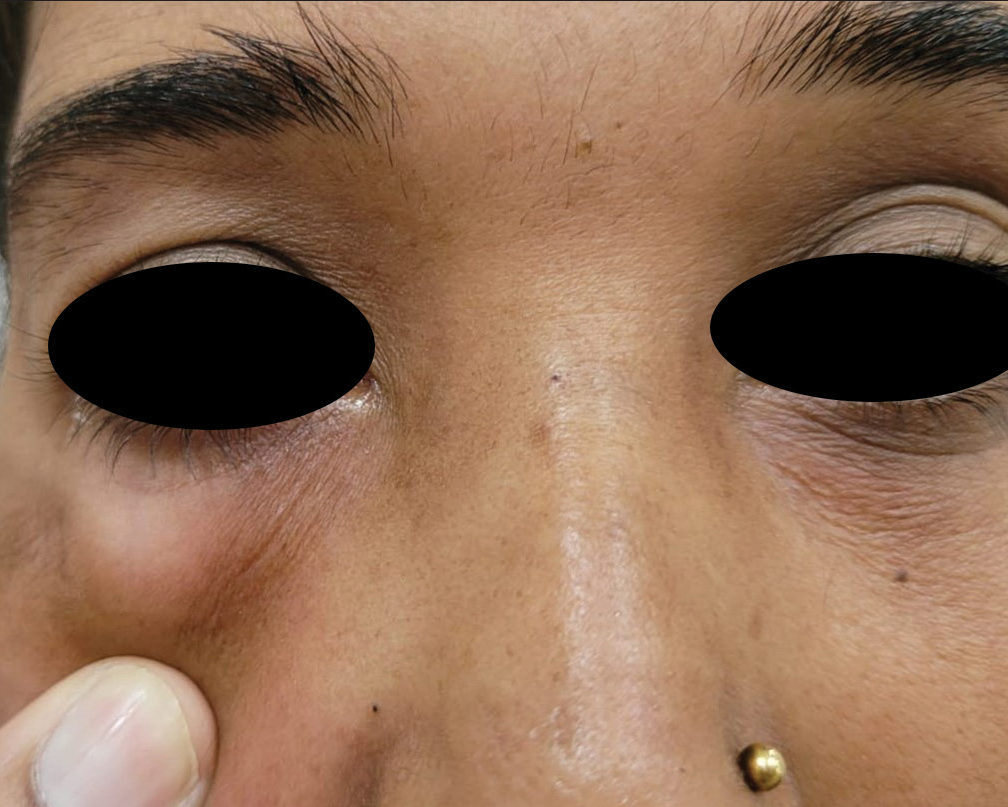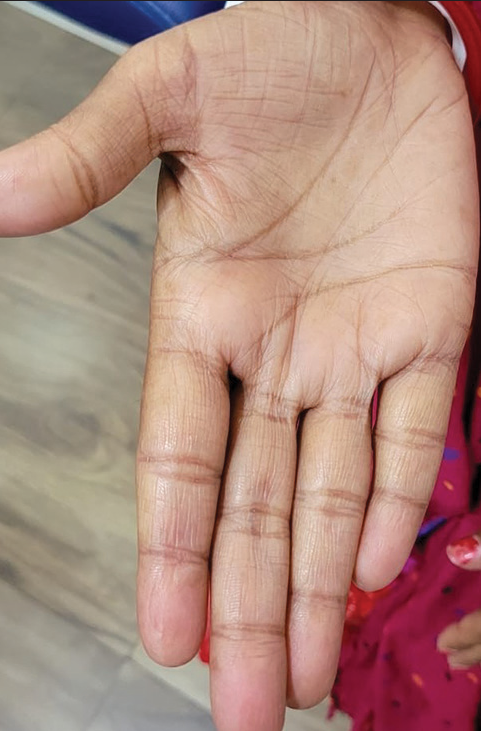Translate this page into:
Autoimmune hepatitis and myositis as presenting manifestation of mixed connective tissue disease – A case report

*Corresponding author: Praveen Kumar Yadav, Department of Neurology, Aarogyam Neuroclinic, Durgapur, West Bengal, India. dr.praveen4u@gmail.com
-
Received: ,
Accepted: ,
How to cite this article: Yadav PK, Maurya SK. Autoimmune hepatitis and myositis as presenting manifestation of mixed connective tissue disease – A case report. Med India 2023;2:14.
Abstract
In the course of mixed connective tissue disease (MCTD), hepatitis is very rare. Most commonly liver steatosis or elevated liver enzymes are reported and only a few cases of MCTD associated with autoimmune hepatitis were described previously. We report a case of 30-year-old female, who initially presented with autoimmune hepatitis and was treated with oral Prednisolone. Few weeks later, she presented with lower motor neuron weakness of all four limbs with normal reflexes and sensory findings. Clinically, the pattern of weakness was suggestive of a myopathic process which was confirmed with a high creatine phosphokinase levels and electromyography. She had history of Raynaud’s phenomenon with minimal skin thickening involving the extremities and face. Thus, a diagnosis of overlap syndrome/MCTD was kept. MCTD has been confirmed on high titers positive anti U-1 ribonucleoprotein antibodies. Autoimmune hepatitis and myositis as the presenting manifestation are very rare. Here, we highlight a patient of MCTD with initial symptoms of autoimmune hepatitis and myositis.
Keywords
Mixed connective tissue disease
Autoimmune hepatitis
Myositis
Raynauds
INTRODUCTION
Mixed connective tissue disease (MCTD) is a rare systemic autoimmune disease. It was first described in 1972 by Sharp et al.,[1] and refers to a systemic autoimmune disease with a combination of features resembling systemic lupus erythematous (SLE), cutaneous systemic sclerosis, dermatomyositis, and rheumatoid arthritis.[2] Common clinical manifestations of MCTD are Raynaud’s phenomenon, arthralgia, swollen joints, esophageal dysfunction, muscle weakness, and fingers sausage-like appearance along with the presence of anti-ribonucleoprotein (RNP) antibodies. During the progression of the disease, pulmonary, renal, cardiac, gastrointestinal, and central nervous system manifestations may evolve.[3] High titers of anti-U1 RNP antibodies (anti-U1 RNP) are characteristic of MCTD.[4] Interstitial lung disease and pulmonary arterial hypertension can evolve during the long course of disease and may influence disease prognosis.[5] Autoimmune hepatitis (AIH) is an immune mediated inflammation of the liver of unknown etiology, which leads to progressive inflammation and fibrosis in the liver.[6]
CASE REPORT
A 30-year-old female, who was previously normal without any other systemic illness, presented with subacute onset of weakness in all four limbs for the past 1-month duration. This was associated with pain in limbs and weakness in neck flexion. There was no history of sensory symptoms, no cramps of muscle, no fatigability, and no diurnal variation.
Past history
There was a history of jaundice, which was diagnosed as AIH and it was being treated by Gastroenterologist. She was on steroid therapy. There was a history of taking Prednisolone 60 mg once daily started dose, then gradually tapered and now she was on maintenance dose of 20 mg/day. She had abnormal liver function test and antinuclear antibody (ANA) was positive. On treatment with steroids, she developed weakness in limbs along with on/off joint pain and Raynaud’s phenomenon for the past 6 months.
On examination
General examination showed normal peripheral pulse, temperature, blood pressure, and oxygen saturation. There was mild skin tightening around the lower eyelids [Figure 1]. Raynaud’s phenomenon was also noted during examination [Figure 2]. There was Grade 3 power in proximal upper limb and Grade 4 (−) power in distal lower limb. Deep tendon reflexes were elicited and plantar reflex was normal (flexor). There was no cranial nerve involvement, no cognitive issue and no wasting or fasciculation seen.

- Facial skin tightening.

- Mild Raynaud’s phenomenon.
Patient was further evaluated, routine blood counts were normal, and fasting sugars, glycated hemoglobin (HBAIC level), and thyroid function tests were normal. Specific tests such as serum creatine phosphokinase (S. CPK) were elevated (3000 U/L), lactate dehydrogenase (LDH) was raised (1597 U/L), and ANA profile showed high titers positive anti U-1 RNP antibodies. In view of the background history of AIH and now with features of inflammatory myositis, Raynaud’s phenomenon, and skin thickening with high titer positive U1 RNP antibodies, a diagnosis of MCTD was made. After that, patient was referred to rheumatologist for further management.
Laboratory findings
Table 1 summarizes the key laboratory findings.
| Serum bilirubin | 0.83 mg/dL |
| Total protein | 6.0 g/dL |
| Serum albumin | 2.6 g/dL |
| Serum globulin | 3.4 g/dL |
| Serum alkaline phosphatase | 55 U/L |
| SGOT | 273 U/L |
| SGPT | 259 U/L |
| LDH | 1597 U/L |
| PT | 11.1 s |
| INR | 0.85 |
| Serum CPK | 3000 U/L |
| Anti U-1 RNP antibody | Positive (+++) |
SGPT: Serum glutamic-pyruvic transaminase, SGOT: Serum glutamic-oxaloacetic transaminase, LDH: Lactate dehydrogenase, PT: Prothrombin time, INR: International normalized ratio, RNP: Ribonucleoprotein, CPK: Creatine phosphokinase
DISCUSSION
MCTD is a specific condition in which two or more connective tissue disorders are associated with presence of a specific Uridine rich U1 RNP antibody.[7] Connective tissue disorders can present with a plethora of signs and symptoms. Diagnosis of these disorders is made based on specific criteria. Major connective tissue diseases are SLE, systemic sclerosis, rheumatoid arthritis, polymyositis, dermatomyositis, and primary Sjogren’s syndrome. Clinical features of MCTD may overlap between these diseases.
According to the Alarcon-Segovia criteria for diagnosis of MCTD, there are five clinical symptoms – (swollen hands, synovitis, myositis [biologically or histologically proven], Raynaud’s phenomenon, acrosclerosis with or without proximal systemic sclerosis), and anti-RNP positivity. The presence of at least three out of five clinical symptoms and anti-RNP positivity is required for diagnosis of MCTD.
There are only few cases of MCTD, who developed AIH, were described previously. In one report from Korea, a 40-year-old female patient suffering from overlap syndrome of MCTD and Sjogren’s syndrome was admitted to hospital with severe cholestasis AIH and acute liver failure.[8] In another report, a 16-year-old female with MCTD, developed AIH after 1 year of disease onset.[9] In another report, one 27-year-old female with MCTD was associated with chronic hepatitis and thyroiditis.[10] One other report, in which an 11-year-old boy admitted to hospital with hepatitis along with symptoms and signs of MCTD, who was diagnosed with MCTD with AIH after further investigations.[11]
We present a case of 30-year-old woman, who presented with features of myopathy along with AIH. As she was on steroid therapy for AIH, possibility of steroid induced or connective tissue disease related myopathy was considered as there was myopathy along with skin changes and Raynaud’s phenomenon. Hence, MCTD was considered provisionally. On further evaluation, S. CPK was raised (3000 U/L) with raised LDH (1597 U/L) and ANA profile showed high titers positive anti U-1 RNP antibodies. These all favor the diagnosis of MCTD and diagnosis was made based on Alarcon-Segovia criteria with raised titer of anti U-1 RNP antibody and three out of five clinical criteria (myositis as proven by elevated CPK level; acrosclerosis; and Raynaud’s phenomenon).
AIH was the first presenting manifestation and other signs and symptoms of MCTD Appeared later. In other previous reports, all the patients were either previously diagnosed case of MCTD, who develops AIH later, or presented with symptom and signs of MCTD along with autoimmune hepatitis.
CONCLUSION
AIH as an initial presentation of MCTD is very rare. In this case, AIH and myopathy were the presenting manifestations of MCTD.
Author contributions
Both authors were fully involved in writing the article.
Declaration of patient consent
Patient’s consent not required as patients identity is not disclosed or compromised.
Conflicts of interest
There are no conflicts of interest.
Financial support and sponsorship
Nil.
References
- Mixed connective tissue disease--an apparently distinct rheumatic disease syndrome associated with a specific antibody to an extractable nuclear antigen (ENA) Am J Med. 1972;52:148-59.
- [CrossRef] [PubMed] [Google Scholar]
- Mixed connective tissue disease-enigma variations? Rheumatology (Oxford). 2017;56:326-33.
- [CrossRef] [PubMed] [Google Scholar]
- Mixed connective tissue disease: An overview of clinical manifestations, diagnosis and treatment. Best Pract Res Clin Rheumatol. 2012;26:61-72.
- [CrossRef] [PubMed] [Google Scholar]
- Mixed connective tissue disease: A clinicopathologic study of 20 cases. Semin Arthritis Rheum. 1980;10:25-51.
- [CrossRef] [PubMed] [Google Scholar]
- The diagnosis and classification of mixed connective tissue disease. J Autoimmun 201448-9, 46-9
- [CrossRef] [PubMed] [Google Scholar]
- Diagnosis and management of autoimmune hepatitis. Hepatology. 2010;51:2193-213.
- [CrossRef] [PubMed] [Google Scholar]
- Mixed connective tissue disease. Curr Opin Rheumatol. 2000;12:386-90.
- [CrossRef] [PubMed] [Google Scholar]
- A case of cholestatic autoimmune hepatitis and acute liver failure: an unusual hepatic manifestation of mixed connective tissue disease and Sjögren's syndrome. J Korean Med Sci. 2001;16:512-5.
- [CrossRef] [PubMed] [Google Scholar]
- Aggressive autoimmune hepatitis in a case of mixed connective tissue disease. APLAR J Rheumatol. 2007;10:146-9.
- [CrossRef] [Google Scholar]
- Mixed connective tissue disease associated with autoimmune hepatitis and thyroiditis. Ann Rheum Dis. 1992;51:544-6.
- [CrossRef] [PubMed] [Google Scholar]
- Autoimmune hepatitis as a presenting manifestation of mixed connective tissue disease in a child Case report and review of the literature. Pediatr Rheumatol. 2015;13:47.
- [CrossRef] [PubMed] [Google Scholar]






